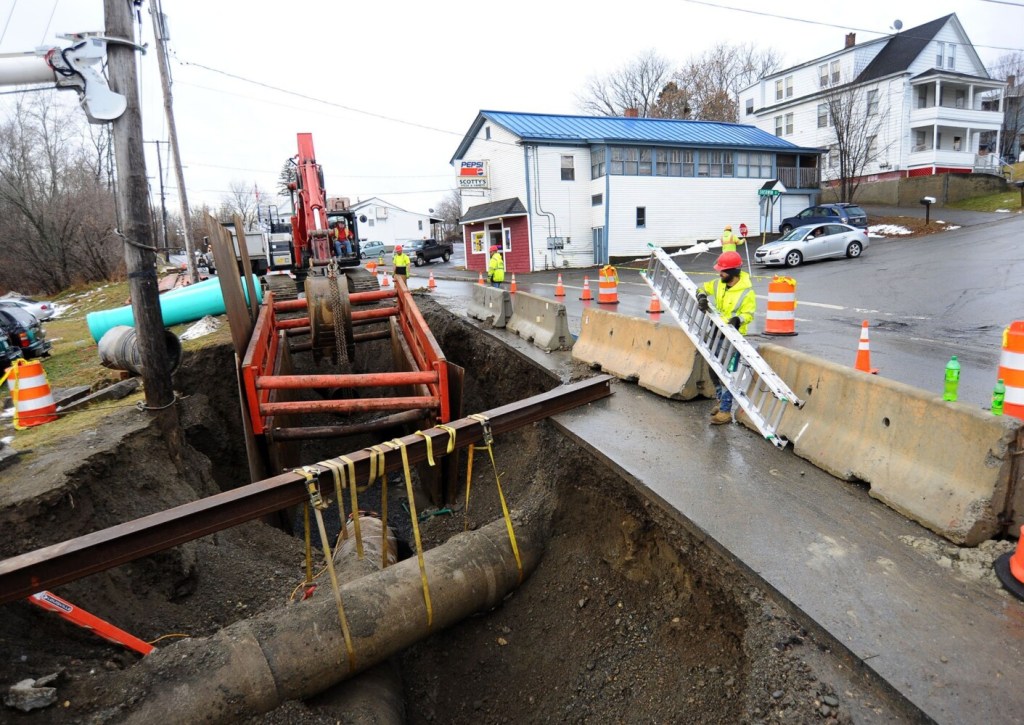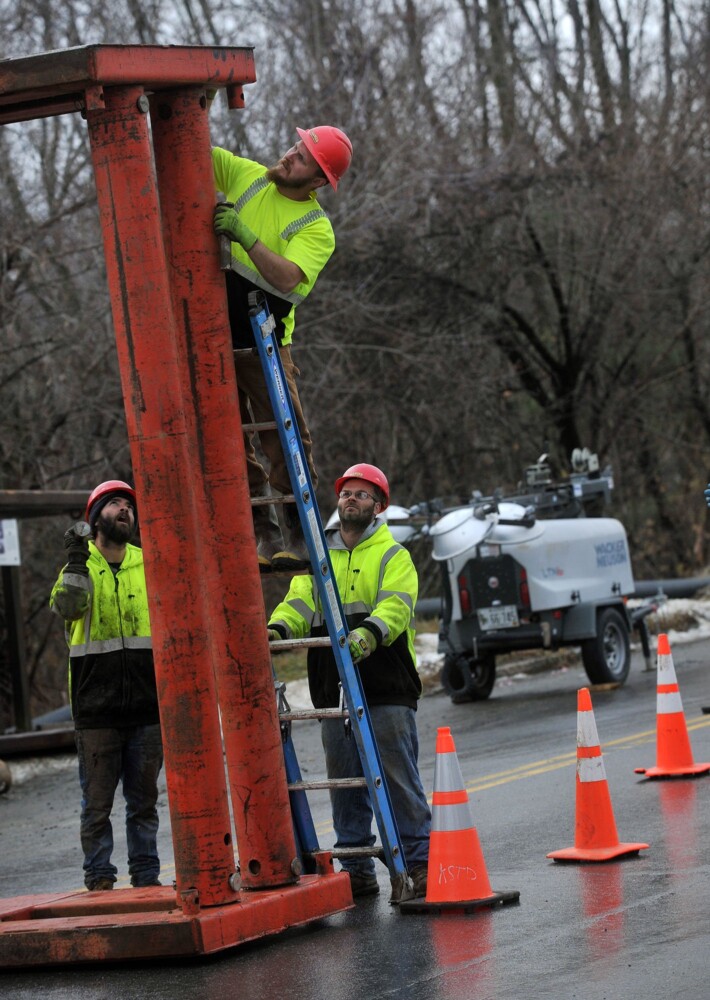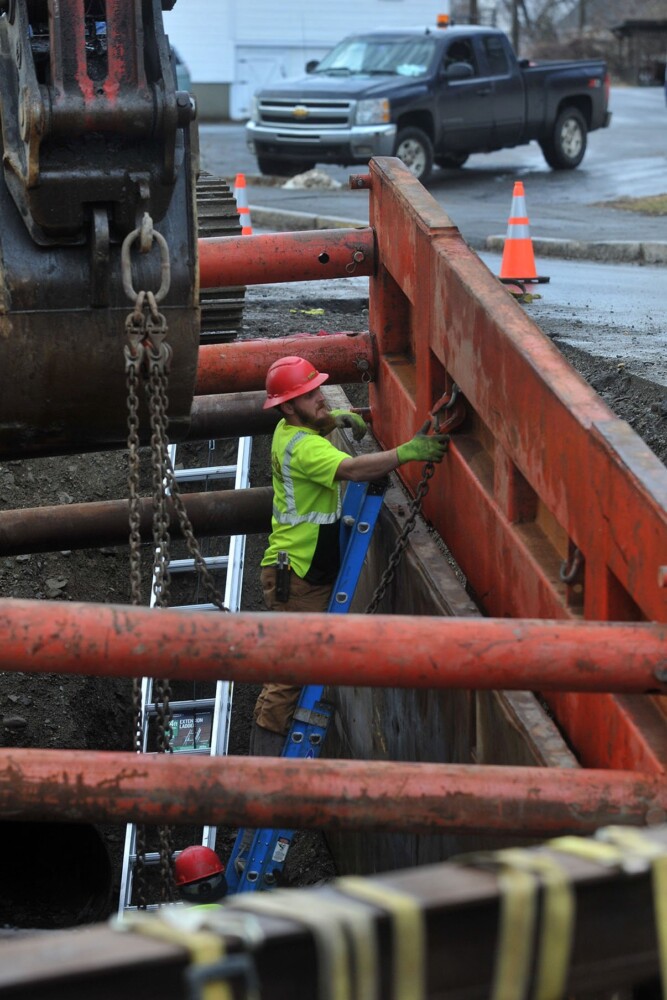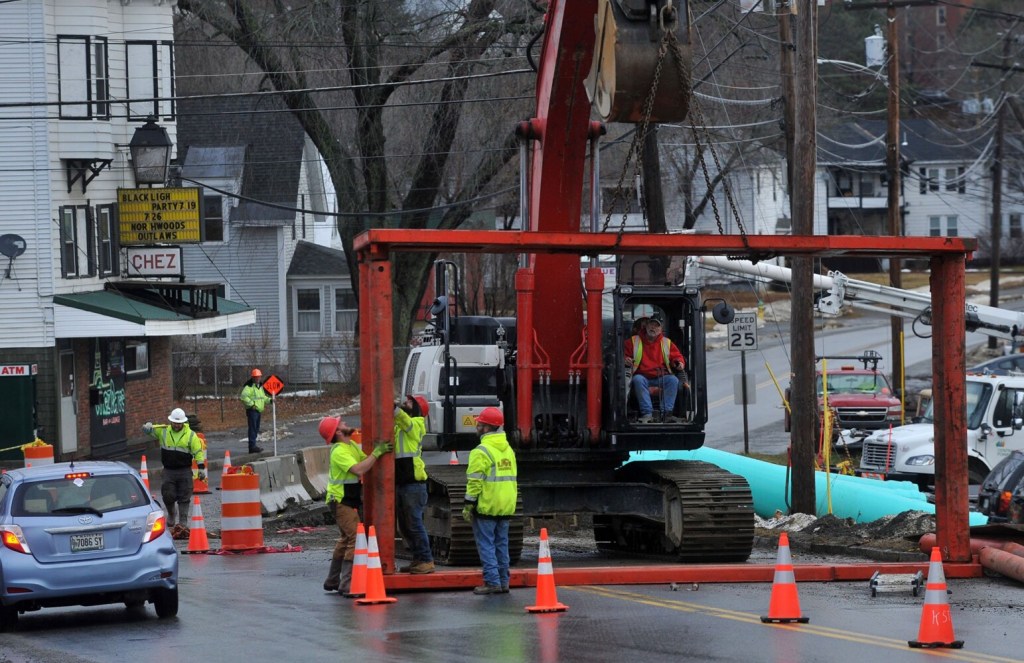WATERVILLE — When voters at the polls consider borrowing money for infrastructure, they understand when that funding is needed for bridges and roads because roads and bridges are visible.
Not so with the underground, out-of-sight world of sewer and water pipes which also are important to their health and the health of the state.
Sometimes the only way people understand the critical need for replacing old wastewater infrastructure is when pipes break, sending sewerage into waterways, as occurred several days ago in Waterville.
Timothy LeVasseur, superintendent of the Kennebec Sanitary Treatment District, said Tuesday that 34 million gallons of sewerage flowed into the nearby Kennebec River as a result of the main break — much more than his original estimate of 15 million gallons.

Workers secure a trench box after it was lowered into a hole on Water Street on Tuesday in Waterville. The hole was dug after underground sewerage and stormwater lines connected with the Kennebec Sanitary Treatment District Pumping Station in Waterville broke. Morning Sentinel photo by Rich Abrahamson Buy this Photo
The break occurred on Water Street, near the east end of Sherwin Street in the city’s South End where a Treatment District pumping station is using a temporary bypass system to send the sewerage to the treatment plant on the south end of Water Street.
Discovered Nov. 29, the extent of the problem was difficult to track because a contractor in 1974 had cut a 36-inch gravity-driven stormwater pipe and placed a 30-inch main force sewer pipe on top of and inside it for a length of 15 feet, and then poured concrete, entombing the arrangement in a block about the size of a pickup truck.
That recent discovery was startling by all accounts, and required a team effort by the Kennebec Sanitary Treatment District, Kennebec Water District, Waterville Sewerage District, contractors, the city and others to help resolve the issue. It also opened eyes.
“I think everyone in the state supports clean water, but not everyone realizes those facilities and this infrastructure is the foundation of why we have clean water,” Brian Kavanah, director of the Bureau of Water Quality in the state Department of Environmental Protection, said Tuesday.
Kavanah said the significant sewerage flow into the river in Waterville was “not a good situation.”
“This is a pretty big one,” he said.
The raw sewerage might cause higher levels of bacteria in the river, according to Kavanah. When micro organisms feed on the bacteria, it can depress oxygen in the water, he said.
“That’s less of a concern in the wintertime because colder water holds higher levels of oxygen than warmer water,” he said.
Fortunately, the leak happened when fewer people were swimming or recreating on the river, according to Kavanah. It is not unusual, he said, to see one or two such sewer main breaks in Maine within a month, though they happen to varying degrees.
“It gets to the whole issue of this is infrastructure that has to be maintained,” he said.
LeVasseur said Tuesday that the stormwater pipe had arrived earlier in the day from Montreal and crews installed it after building up and stabilizing the area around the pipes in the excavation site. By Wednesday, they hoped to start installing the new sewer force main.
“They’re putting water plugs on either end to seal it,” LeVasseur said of the stormwater pipe. “We ended up putting in just under 30 feet.”
Workers hope to complete the project by the end of the week, but it may take a couple of days longer, according to LeVasseur.
“I feel extremely relieved that everyone has the parts they need,” he said. “Mother Nature threw another curve at us with the rain. The bypass system is working beautifully. That’s important.”
Meanwhile, state Rep. Bruce White, of Waterville, said he agrees that taking care of wastewater infrastructure is imperative.
“This legislative session, I was happy to support L.D. 347, ‘An Act To Provide Sustainable Funding for Drinking Water and Wastewater Infrastructure,’ which passed and was signed into law by Gov. Mills. I will continue to support similar measures in the future,” he said.

Water Street traffic is down to one lane after 30-inch lines connected to the Kennebec Sanitary Treatment District Pumping Station in Waterville broke. Workers prepare to lower a trench box into the hole where work was underway Tuesday. Morning Sentinel photo by Rich Abrahamson Buy this Photo
There are 162 large and small municipal or quasi-municipal wastewater treatment facilities all over the state that were built after funding became available with the Clean Water Act in 1972, according to Kavanah. Most were built in the late 1970s, ’80s and ’90s, and some sewer systems were built 100 years ago, he said. Those sewer systems take waste from homes, businesses and some industries and treat it so that it is clean enough to release. The systems built in the ’70s and ’80s have a lifespan of 25 to 30 years and include mechanical and other systems that must be upgraded, according to Kavanah.
“In Maine, there’s $1 billion of needs in terms of upgrading all of that,” he said. “It’s a very expensive and important endeavor — that there’s adequate funding.”
Funding for upgrades can come from the federal government and state bonds, and the DEP advocates for additional grant dollars, he said. The DEP recognizes that people need to have affordable sewer bills, he said.
“In 2018, a $30 billion budget package was passed by the Legislature and we distributed about half of that so far and put out a request for the other half to be distributed in January,” Kavanah said.
The state has generally been supportive of spending money on wastewater infrastructure, but there was a dry spell between 2010 and 2018, when no wastewater bonds were passed, according to Kavanah. Such bonds must be introduced to the Legislature, passed and sent to voters, and there is always competition for dollars.
“It can change from administration to administration, legislature to legislature, and there are a lot of different priorities,” he said.
Kavanah said a bill, L.D. 1779, was introduced in the legislature late last session and will be carried over into 2020. It would authorize the DEP to do some rule-making and come up with standards for how all wastewater facilities will be run, requiring them to have an assessment management plan that includes a list of its infrastructure. That list would include what the infrastructure is made of, how old it is and what condition it is in, what its life span is, and if it breaks, how much it would cost to repair it and where the funds would come from. Such a bill would help DEP advocate better for funding and making policy.
Meanwhile, helping to raise awareness about infrastructure and facilities is “extremely important,” according to Kavanah.
“It protects the water of the state, and public health, and serves as a foundation for a strong economy, and we really need to maintain it moving forward,” he said.
Copy the Story LinkSend questions/comments to the editors.







Success. Please wait for the page to reload. If the page does not reload within 5 seconds, please refresh the page.
Enter your email and password to access comments.
Hi, to comment on stories you must . This profile is in addition to your subscription and website login.
Already have a commenting profile? .
Invalid username/password.
Please check your email to confirm and complete your registration.
Only subscribers are eligible to post comments. Please subscribe or login first for digital access. Here’s why.
Use the form below to reset your password. When you've submitted your account email, we will send an email with a reset code.